by Su C. Tung, George C. Yao

This is an urban housing construction. Typically, these are 12-story apartment buildings with a parking area in the basement. The first and second floor are classified as Open Space (OS) and the ground floor is used by the residents for gardening and for leisure and social gatherings. The common features in these buildings are: (1) The two lower floors were designed for the OS with a net height of approximately 7.6 meters. (2) There are many walls above the third floor in both horizontal directions but very few walls on the OS except around the elevator shaft and the staircases. If the elevator is located at the corner of the building, torsional effect may be present. (3) Architects tend to design zigzag floor plans for these buildings in order to maximize view angle and natural lighting. (4) Very few columns were designed into these buildings in order to maximize the parking area on the basement level. The primary load-resisting system is reinforced concrete moment-resisting frame on a mat foundation. The fact that the partition walls are dense at the third floor and above, creates a soft-story configuration in the lateral load-resisting system. Many buildings of this type collapsed in the 1999 Chi-Chi earthquake due to the soft-story effect caused by the OS design
Report # 62 : Street front building with arcade at the first floor (contemporary construction)
by George C. Yao, M. S. Sheu
This building type is common in many Taiwanese cities and towns. The street-front buildings are medium-rise, reinforced concrete frames with infill brick masonry walls serving as partitions. Usually, the first floor (typically 4 m high) is used for commercial purposes while the upper stories (typically 2 to 4 stories above, floor height 3 m) are used for storage and residences. Neighboring units of similar design have been constructed together to form a corridor for pedestrians to walk in. Connected units vary in number from 6 to 10 and they may be built in a row, in an L shape, or in the U shape. There are several structural deficiencies associated with this building type: (1) the weak and soft first story can result from a large opening at the street level for commercial use; (2) a typical building layout has walls in one direction only, perpendicular to the street; as a consequence, there are few earthquake-resisting elements in the other direction; (3) extra rooftop additions increase loads. Also, building owners tend to reduce the number of columns for a wider storefront view. Many buildings of this type collapsed in the Chi-Chi earthquake of 1999
Report # 61 : Street front building with arcade at the first floor (pre-1970’s construction)
by George C. Yao, M. S. Sheu
This building type is common in most Taiwanese cities and towns. It represents a construction practice that was followed before1970 and is no longer used. The main load-bearing structure consists of reinforced concrete frames designed for gravity loads only, with brick masonry infill walls. Brick walls were built before the concrete was poured thereby serving as a formwork for concrete. Buildings of pre-1970 construction were characterized with a better bond between the masonry and concrete as compared to the buildings of more recent construction, in which reinforced concrete frames serve as main load-bearing system for lateral and gravity loads. Buildings of this type are medium-rise (4 to 5 stories high). Usually, the first floor (typically 4 m high) is used for commercial purposes while the upper stories (typically 2 to 4 stories above, floor height 3 m) are used for storage and residences. Neighboring units of similar design are constructed together to form a shady corridor for pedestrians to walk in. The number of connected units varies from 6 to 10. These units may be connected in one row, or in an L shape, or in the U shape along the street block. There are several structural deficiencies characteristic for this construction: (1) the weak and soft first story because the commercial space demands a large opening at the street level; (2) typical building layout has walls in one direction only, perpendicular to the street. As a consequence, there are few earthquake-resisting elements in the other direction; (3) extra rooftop additions increase the load. Many buildings of this type collapsed in the 1999 Chi-Chi earthquake.



